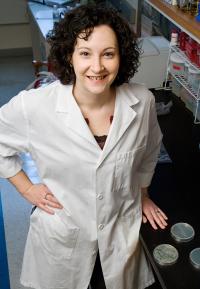
Microbiology professor Carin Vanderpool has identified the unique metabolic activities of one of the small ribonucleic acids in bacteria called SgrS. They are often overlooked, and were once thought to be too small to contribute much to major cellular processes, but in recent years the study of small ribonucleic acids (sRNA) has gained momentum. Now a team from the University of Illinois has identified the unique metabolic activities of one of these bit players, a 200-nucleotide-long RNA molecule in bacteria called SgrS.
This molecule is one of about 80 known small RNAs common to many bacteria. It got its name for its role in sugar metabolism (SgrS is an acronym for sugar-related stress). When a bacterium such as Escherichia coli has taken up enough – or too much – glucose from its surroundings, SgrS helps stop the transport of glucose molecules across the cell membrane, said microbiology professor and principal investigator Carin Vanderpool.
In trying to tease out how SgrS performs this task, Vanderpool and technician Caryn Wadler discovered that the molecule performs dual roles, both of which inhibit the transport of glucose into the cell. One region of the RNA molecule binds to a messenger RNA to inhibit the production of new glucose transporters, while another region codes for a protein that seems to retard the activity of existing transporters.
The findings appear online this month in the Proceedings of the National Academy of Sciences.
“The most novel thing about this discovery is that this molecule seems to be truly bi-functional in that the two functions it performs participate in the same stress response,” Vanderpool said.
One other small RNA, a 500-nucleotide molecule that regulates virulence genes in Staphylococcus aureus bacteria, was previously found to encode a protein, Vanderpool said, but the activity of that protein did not participate in the regulation.
The two regions of the molecule were apparently engaged in unrelated tasks.
Some glucose is obviously good, since the bacteria use it to make essential cell molecules and to provide energy. However, excess glucose in bacterial cells interferes with vital functions, Vanderpool said, so the SgrS response is essential to bacterial survival. A deeper understanding of how bacteria defend themselves from metabolic stresses such as excess glucose could lead to important therapeutic innovations, she said.
Vanderpool hopes that more researchers will explore the multifunctional potential of these diminutive molecules.
“Don’t overlook them just because they’re short,” she said.
Source : University of Illinois at Urbana-Champaign
 Print Article
Print Article Mail to a Friend
Mail to a Friend
